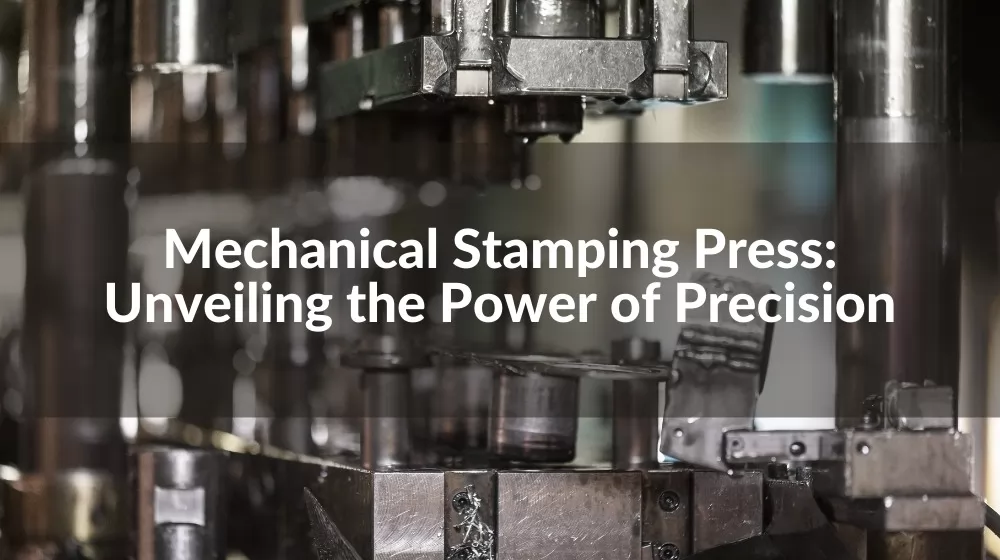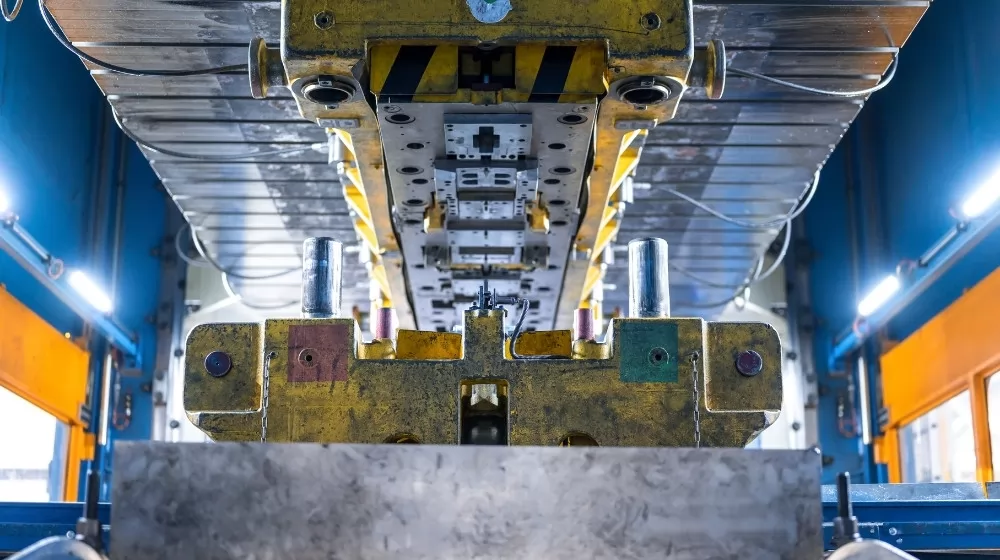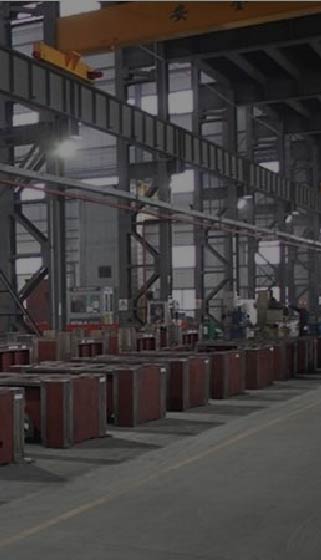








Welcome to the fascinating world of Mechanical Stamping Presses, a domain where precision, efficiency, and innovation converge. In this comprehensive guide, we delve into every aspect of mechanical stamping, from its basic principles and key components to the diverse applications and essential safety measures. Whether you're a seasoned professional in the manufacturing industry or simply intrigued by the mechanics of metal shaping, this article promises to enlighten and inform. Join us on this journey to uncover the intricate workings of mechanical stamping presses and their pivotal role in modern manufacturing.
Have you ever wondered how those intricate metal parts in your car, the detailed components in electronic devices, or even the simple yet precise metal shapes used in everyday appliances are made? Well, let me introduce you to a game-changer in the world of manufacturing – the Mechanical Stamping Press. This marvel of engineering is not just a tool; it's the backbone of modern manufacturing, transforming sheets of metal into complex shapes with precision and efficiency.
At its core, a mechanical stamping press is a machine that uses force to shape or cut metal sheets into specific forms. This is achieved through a process known as stamping - a cold-forming operation that can include punching, embossing, bending, flanging, and coining. Think of it as a powerful press that molds metal sheets with the finesse of an artist and the strength of a giant. The press operates by transferring energy stored in a rotating flywheel to a ram, which then applies the necessary force to the die and workpiece.
What sets the mechanical stamping press apart in the industrial arena is its versatility and efficiency. Capable of handling various materials and thicknesses, it’s a preferred choice for high-volume production. From automotive parts to electronic components, its applications are as diverse as they are essential. The precision it offers is unmatched, ensuring that each piece produced is a carbon copy of the last, maintaining quality and consistency.
Diving deeper into the world of mechanical stamping presses, it's crucial to understand the key components that make up this powerful machine. Each part plays a significant role in ensuring the press operates with precision and efficiency. So, what are these components, and how do they contribute to the overall functionality of a stamping press? Let’s break it down.
1. Frame: The frame is the backbone of the stamping press. It supports all other components and withstands the operational stresses. Typically made of high-strength steel, the frame ensures the stability and durability of the press during the stamping process.
2. Drive Mechanism: This is the heart of the press. The drive mechanism, often a motor connected to a flywheel, provides the necessary force to the ram. It's responsible for the energy transfer that powers the stamping operation. In a mechanical stamping press, the precision and consistency of this mechanism are paramount.
3. Ram (Slide): The ram, or slide, is the moving component that applies force to the metal. Attached to the drive mechanism, it moves up and down, delivering precise pressure to form the metal sheets. The ram's accuracy and smooth movement are crucial for high-quality stamping.
4. Die Set: The die set, comprising the punch and die, is where the actual shaping occurs. The die has a cavity that mirrors the desired shape, while the punch is the part that forces the metal into the die. The intricate designs of these components are what make the detailed stamping possible.
5. Bolster Plate: This is the surface on which the die set is mounted. The bolster plate needs to be exceptionally robust and accurately machined to ensure that the die remains perfectly aligned during the stamping process.
6. Control System: In modern presses, the control system plays a pivotal role. It's the brain of the operation, overseeing the coordination and timing of the press's movements. Advanced control systems can optimize the stamping process for efficiency and precision, often integrating with digital monitoring systems for quality control.
After exploring what a mechanical stamping press is and its key components, let's delve into how this impressive machinery operates. The process might seem complex, but it’s a fascinating symphony of precision engineering and mechanical prowess. Here’s a step-by-step breakdown of the stamping process.
Step 1: Material Feeding
The journey begins with feeding the raw material, typically metal sheets, into the stamping press. This is usually done automatically via rollers or a feeding mechanism, ensuring the material is positioned accurately for stamping.
Step 2: The Drive Mechanism in Action
Once the material is in place, the drive mechanism springs into action. The motor powers the flywheel, converting electrical energy into mechanical energy. This energy is then transferred to the ram, moving it towards the material with controlled force.
Step 3: Stamping Process
As the ram descends, it presses the metal sheet against the die set. The die, with its custom-shaped cavity, and the punch work together to deform the metal into the desired shape. This could be anything from simple flat shapes to more complex three-dimensional forms.
Step 4: Ejection and Collection
After the stamping is complete, the ram retracts, and the finished part is ejected from the die. It’s then collected, often by automated systems, for further processing or assembly.
Step 5: Quality Control
Throughout the process, quality control is paramount. Modern stamping presses often include sensors and monitoring systems that check for consistency and precision, ensuring every part meets stringent quality standards.
Mechanical stamping presses come in various types, each designed to meet specific needs in the manufacturing world. From single action to double action, and hydraulic to mechanical, the diversity in these machines is key to their application in different sectors. Let's explore these types, including some specialized variants like progressive, transfer, and tandem presses.
Single Action Presses: These are the most basic form of stamping presses. In a single action press, the ram, which holds the die, moves in a single, straightforward motion. Ideal for simpler operations, they are widely used for tasks like blanking and punching.
Double Action Presses: More complex than their single action counterparts, double action presses feature two rams. The first ram, usually the outer one, controls the blank holder, while the inner ram performs the actual stamping. This dual mechanism allows for more intricate operations, like deep drawing, without sacrificing precision.
Hydraulic Presses: These presses use hydraulic cylinders to generate force. Known for their ability to apply consistent pressure over a longer stroke, hydraulic presses are preferred for applications requiring detailed work and precision.
Mechanical Presses: Mechanical stamping presses use a motor-driven mechanical flywheel to generate force. They are typically faster than hydraulic presses and are ideal for high-volume production runs where speed and efficiency are key.
Progressive Presses: These presses use a series of dies in a single pass to perform multiple operations. The metal strip moves through the press, and different operations are performed at each station. Progressive presses are highly efficient for complex, multi-step parts.
Transfer Presses: Transfer presses move the workpiece from one station to another. Each station performs a different operation, making them ideal for complex parts that require multiple processes.
Tandem Presses: These are a series of mechanical presses linked together, allowing for sequential operations. Parts are transferred automatically between presses. Tandem setups are used for large parts requiring multiple stamping operations, such as automotive body panels.

The design and construction of a mechanical stamping press are pivotal in determining its efficiency, durability, and safety. This stage involves meticulous planning and precision, from selecting the right materials to integrating essential safety features. Let's delve into these critical aspects of stamping press design and construction.
The choice of materials for constructing a stamping press significantly influences its performance and longevity. High-strength steel is commonly used for the frame, providing the necessary robustness to withstand the immense forces during stamping operations. For moving parts like the ram, materials that balance strength and wear resistance are vital to ensure smooth operation over extended periods. Additionally, the die set, the heart of the stamping process, often uses tool steels or carbide alloys, known for their hardness and durability to maintain precision in shaping metal parts.
Structural design is another cornerstone in the construction of a stamping press. The design must ensure maximum stability and resistance to deflection under load. This involves engineering the frame and components to handle the specific force and speed requirements of the intended operations. In addition, factors like load distribution, alignment, and ease of maintenance play crucial roles in the overall design. Modern stamping presses also integrate modular designs that allow for adaptability and upgradability, catering to evolving manufacturing demands.
Safety is paramount in the design of a stamping press. These machines are equipped with various safety features to protect operators and ensure smooth operation. This includes guards and shields to prevent access to moving parts, emergency stop mechanisms, and light curtains or sensors that halt operations if a foreign object or hand gets too close to the working area. Additionally, many stamping presses now incorporate advanced monitoring systems that detect anomalies in operation, automatically shutting down the press to prevent accidents or equipment damage.
Understanding the operating principles of a mechanical stamping press is key to appreciating its capabilities in precision manufacturing. This involves a deep dive into the step-by-step stamping process, how precision is controlled, and the factors influencing speed and efficiency. Let's explore these principles to grasp the full potential of stamping presses.
The stamping process involves a series of steps, each critical to the final outcome:
Precision in stamping is achieved through a combination of accurate die design, proper alignment of the press components, and precise control of the ram movement. Modern stamping presses use sophisticated control systems that monitor and adjust the press operation, ensuring consistent quality and reducing the risk of defects. Additionally, regular maintenance and calibration of the press are essential to maintain its precision.
The speed and efficiency of a stamping press are influenced by several factors:
The applications of mechanical stamping presses are as varied as they are vital in numerous industries. This versatility stems from their ability to efficiently produce a wide range of parts with precision and consistency. Let’s explore some of the key areas where stamping presses make a significant impact.
Automotive Industry: In the automotive sector, stamping presses are indispensable. They are used for creating body panels, frames, and various other components. The precision and strength required for automotive parts make stamping presses ideal for this application.
Electronics and Consumer Goods: Stamping presses also play a critical role in manufacturing parts for electronic devices and consumer goods. From the metal backings of smartphones to the intricate components in household appliances, stamping presses ensure high precision and quality.
Aerospace Industry: In aerospace, the demand for high-strength, lightweight components makes stamping presses invaluable. They are used to form parts of aircraft and spacecraft, where precision and durability are non-negotiable.
Building and Construction: Stamping presses are used in the building and construction industry for creating structural components, HVAC elements, and even decorative metalwork. Their ability to handle large-scale and heavy-duty materials makes them a preferred choice.
Medical Equipment: In the medical field, the precision of stamping presses is used for manufacturing surgical instruments, implants, and other essential equipment. The need for high standards of quality and hygiene in this sector underscores the importance of precise manufacturing processes.
To truly appreciate the capabilities of mechanical stamping presses, it's essential to understand the concepts of force, speed, and capacity. These factors are crucial in determining the suitability of a press for specific tasks and play a significant role in the efficiency and quality of the stamping process. Let’s delve into what each of these terms means and why they are important.
The force of a stamping press, typically measured in tons, refers to the maximum amount of downward force that the press can exert. This force is crucial for shaping metal, as different materials and thicknesses require varying levels of force. A press with a higher tonnage can handle thicker, tougher materials and more complex shapes. It’s all about matching the force to the job at hand.
Speed, usually measured in strokes per minute (SPM), is another vital aspect. It dictates how many times the press can complete a stamping cycle within a minute. Higher speed presses are ideal for high-volume production runs where time efficiency is key. However, speed must be balanced with precision, as overly rapid operations can lead to errors or reduced quality.
Capacity refers to the overall capability of the press, including its maximum sheet size, die size, and material thickness it can handle. It’s a measure of the press’s versatility and adaptability to different tasks. A press with a larger capacity can accommodate a wider range of operations, making it a valuable asset in diverse manufacturing settings.
Like any complex manufacturing process, mechanical stamping comes with its own set of challenges. Addressing these issues effectively is key to maintaining productivity, quality, and consistency. Let’s explore some common challenges in stamping operations and the strategies for troubleshooting and problem-solving.
One major challenge is tool wear, which can lead to reduced precision and part quality. Material deformation issues like warping or wrinkling during stamping are also common, especially when working with thinner or more pliable materials. Misalignment or calibration issues with the press can lead to defects in stamped parts. Additionally, handling high-speed operations without compromising on quality is an ongoing challenge.
To address these challenges, regular maintenance and inspection of the stamping press and tools are essential. This includes checking for wear, ensuring proper alignment, and recalibrating the press as needed. For material deformation issues, adjusting the press settings or using different materials might be necessary. Implementing quality control measures at every stage of the stamping process can help identify and rectify issues early on.
Quality and consistency are the hallmarks of an efficient stamping operation. This can be achieved through a combination of skilled operators, advanced control systems, and rigorous testing protocols. Utilizing modern technology such as computer-aided design (CAD) and automated quality control systems can greatly enhance the precision and consistency of stamped products. Regular training for operators and investing in technological upgrades are also crucial steps towards maintaining high standards in stamping operations.
Choosing the appropriate mechanical stamping press is crucial for any manufacturing operation. The right press not only enhances efficiency but also ensures quality and reduces operational costs. There are several factors to consider when selecting a stamping press, tailored to the specific needs of your projects. Let’s discuss these key considerations to help you make an informed decision.
Begin by evaluating the requirements of your manufacturing processes. Consider the type of material you'll be working with, the thickness of the material, and the complexity of the parts you'll be producing. Understanding these factors will guide you in choosing a press with the appropriate force, speed, and capacity.
The force or tonnage of the press is a critical factor. A press that’s too powerful for your needs can be overkill and less efficient, while an underpowered press won’t achieve the desired results. Align the press’s force with the material type and thickness.
Speed is crucial for high-volume production. However, it should not compromise the precision and quality of the parts. Evaluate the strokes per minute (SPM) in relation to the complexity of the tasks.
The size of the press and its capacity to handle various die sizes and sheet sizes should align with your production needs. Consider not only current requirements but also potential future needs.
Modern stamping presses come equipped with advanced features such as programmable controls, sensors, and automation capabilities. These features can greatly enhance efficiency and precision.
In conclusion, selecting the right mechanical stamping press is a crucial decision that can significantly impact your manufacturing efficiency and product quality. For those seeking the best in this field, look no further than China's leading Metal Press Machine manufacturers and suppliers, JDM. Renowned for their cutting-edge technology, unparalleled precision, and exceptional customer service, JDM stands out in the global market. Discover their extensive range of high-quality stamping presses tailored to meet diverse industrial needs at https://www.jdmpresses.com/. With JDM, you're not just choosing a machine; you're embracing reliability, innovation, and excellence in metal forming technology.
When it comes to mechanical stamping presses, several frequently asked questions arise. Understanding these aspects is essential for anyone involved in or interested in stamping operations. Let’s address some of these common queries.
Hydraulic and mechanical stamping presses differ primarily in their driving mechanisms. A hydraulic press uses hydraulic cylinders to generate force, offering consistent pressure over a longer stroke, making it ideal for detailed, precision work. On the other hand, a mechanical press uses a motor-driven flywheel to generate force, typically operating faster than hydraulic presses, thus suitable for high-volume production runs. The choice between the two depends on the specific requirements of the task, including the material, precision needed, and production volume.
The maintenance frequency for a mechanical stamping press depends on several factors, including the intensity of use, the nature of operations, and the environment in which it operates. Generally, routine maintenance checks should be conducted daily, while more comprehensive servicing, including checking for wear and tear, realignment, and lubrication, should be done monthly or as per the manufacturer’s recommendations. Regular maintenance is crucial to ensure the longevity and optimal performance of the press.
Absolutely! A mechanical stamping press can be used for custom designs. The versatility of these presses lies in the die used. By designing custom dies, you can produce a wide range of shapes and designs. This adaptability makes mechanical stamping presses ideal for bespoke or specialized manufacturing projects.
Operating a stamping press requires adherence to several safety measures to prevent accidents and injuries. These include using protective guards and barriers around moving parts, implementing emergency stop mechanisms, utilizing light curtains or sensors to detect the presence of hands or objects in dangerous areas, and providing proper training to all operators. Regular maintenance and safety checks are also vital to ensure that all safety features are functioning correctly.






